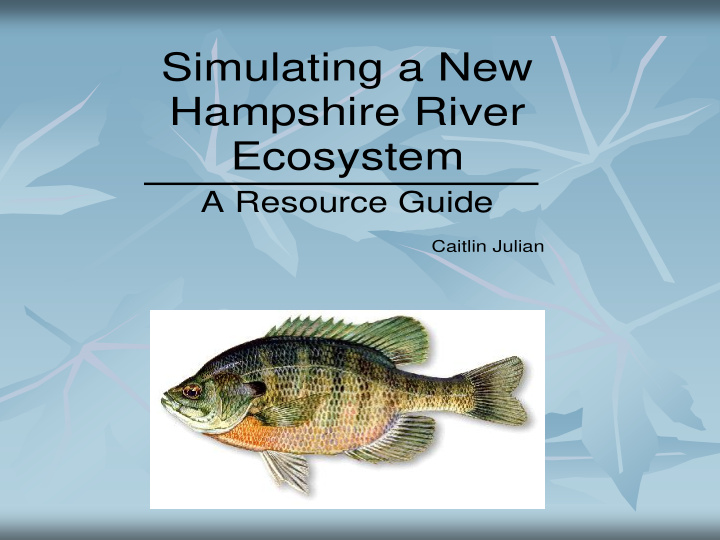



Simulating a New Hampshire River Ecosystem A Resource Guide Caitlin Julian
Written by Caitlin Julian (2001) Revised by Judy Tumosa, NHF&G Watershed Specialist (2009) With assistance from: Dr. Joel Bader, former NHF&G Fish Pathologist Angela Gospodarek, former Raymond Middle School Gabe Gries, former NHF&G Fisheries Biologist Howie Thurston, Let’s Go Fishing Instructor Revised by Judy Tumosa, (2015)
Purpose of a river ecosystem in the classroom Learn more about our warm water fish species ecology and management in NH Learn how fish species interact & behave with their surrounding environment Learn how fish species interact & behave with each other
Lotic or flowing environment for fluvial dependent species W ater Circulation System for “natural” current Ponded environment for macrohabitat generalist species Water Circulation System for “natural” current not needed – design tank more like a pond
Build a Water Circulation System
Provide enough space – 50 gallons minimum
Provide “Natural” Substrate
Provide Cover
Native or fake plants
Provide Healthy Water River water Well or town water – no chlorine
Tank set up Set up for 6-10 days before fish arrive Make the filter the correct size for tank
Now we add the fish
SCIENTIFIC LICENSE APPLICATION TO KEEP WARM WATER FISH IN THE CLASSROOM Note: Only warm water fish species and minnows may be kept (no salmon or trout). Date School Year Teacher name Teacher email School name , address & telephone number Date of collection Collection sites, i.e. specific name of river or pond Method of collection Subpermittees Has attended/will attend training Return to: Judy Tumosa Watershed Education Specialist New Hampshire Fish and Game Department 11 Hazen Drive Concord, NH 03301 #603-271-0456 FAX #603-271-0465 judy.l.tumosa@wildlife.nh.gov
The fish and its habitat needs http://www.wildlife.state.nh.us/fishing/species.html
Current NH Warmwater Species • Largemouth bass • Smallmouth bass • Walleye • Northern Pike • Chain Pickerel • Black Crappie • Bluegill • Pumpkinseed • Yellow Perch • Brown Bullhead (hornpout)
Native NH warmwater Species • Largemouth bass • Smallmouth bass • Walleye • Northern Pike • Chain Pickerel • Black Crappie • Bluegill • Pumpkinseed • Yellow Perch • Brown Bullhead (hornpout)
Coexistence – i.e. Who Eats Whom
How to Collect Electrofishing Netting Seining Angling Bait trap
What do you Feed Them? Other Fish (such as goldfish) Macroinvertebrates Blood Worms Worms Brine Shrimp
How to Maintain the Tank
What do you do with your fish at the end of the year? If they are disease free, put them back where you collected them If they show signs of disease, dispose of them humanely
Why Manage Warmwater Species?
= • 0 vs. 1,000,000 • Natural reproduction typically able to replenish populations • Spawning habitat generally intact • Warmwater fish relatively prolific • Wise management important
How Objectives Are Met • Boat electrofishing + angler surveys • Age and growth • Warmwater database • Habitat restoration/improvement • Bass tournaments: permitting, data collection and data analysis • Special studies: Bass tagging on Winni
Habitat Restoration/Improvement
Panfish. Fish fry!
Aquatic Resources Education (ARE) Program Federally funded State match = teachers and volunteers who provide watershed education in their classrooms Watershed Education Program (WEP) Watershed Ecology Institute (WEI) Let’s go Fishing (LGF)
Water Quality Monitoring Analyze Water quality Compare watershed-wide data
Water Quality Monitoring cont. Identify macroinvertebrates
Aquatic Resource Management Conduct fisheries studies Study in stream features
Warm and Cold Water Tanks
Watershed Mapping & Land Use Assessment Obtain GIS watershed data Identify resource concerns Share data with local and state organizations
Citizen Science Definition From: Cornell Laboratory of Ornithology Citizen Science Central “Projects in which volunteers partner with scientists to answer real world questions.”
NGSS Connections See Section 9 of the “NH F&G Department Watershed Education Program Teacher Manual”
Partners are essential to the mission: Schools, teachers, students statewide Volunteers (TU, LGF, WEP, WEI) UNH, PSU, Keene State, SNHU, EPSCoR, NHGA Watershed Associations, River LAC’s, GMCG, conservation commissions Fisheries biologists, hatchery staff, educators at NHF&G
Goal accomplished: A good day on the river…
So if you are interested in a river ecosystem in your classroom: Contact Watershed Education Specialist Judy Tumosa at NHF&G: judy.l.tumosa@wildlife.nh.gov, #603-271-0456 Fill out registration form to collect and keep fish Attend warmwater fisheries workshop and obtain “Simulating a NH River Ecosystem” manual Have lots of “FIN”
Recommend
More recommend